Intel SSD 520 Review: Cherryville Brings Reliability to SandForce
by Anand Lal Shimpi on February 6, 2012 11:00 AM ESTRandom Read/Write Speed
The four corners of SSD performance are as follows: random read, random write, sequential read and sequential write speed. Random accesses are generally small in size, while sequential accesses tend to be larger and thus we have the four Iometer tests we use in all of our reviews.
Our first test writes 4KB in a completely random pattern over an 8GB space of the drive to simulate the sort of random access that you'd see on an OS drive (even this is more stressful than a normal desktop user would see). I perform three concurrent IOs and run the test for 3 minutes. The results reported are in average MB/s over the entire time. We use both standard pseudo randomly generated data for each write as well as fully random data to show you both the maximum and minimum performance offered by SandForce based drives in these tests. The average performance of SF drives will likely be somewhere in between the two values for each drive you see in the graphs. For an understanding of why this matters, read our original SandForce article.
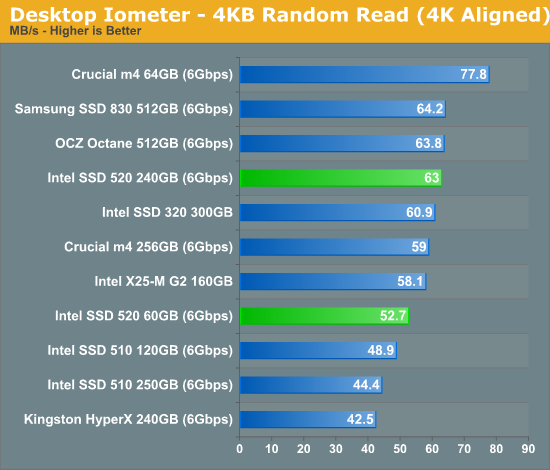
Random read performance seems to have topped out around 60MB/s for most drives and the 520 is no different here.
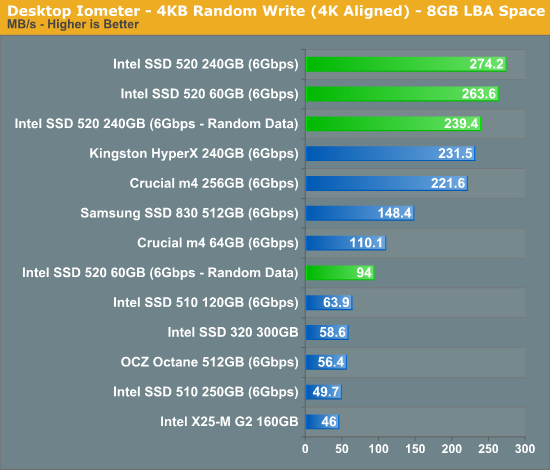
Random write performance, especially with highly compressible data sets the 520 performs beautifully - even outpacing the SF-2281 based Kingston HyperX.
Many of you have asked for random write performance at higher queue depths. What I have below is our 4KB random write test performed at a queue depth of 32 instead of 3. While the vast majority of desktop usage models experience queue depths of 0 - 5, higher depths are possible in heavy I/O (and multi-user) workloads:
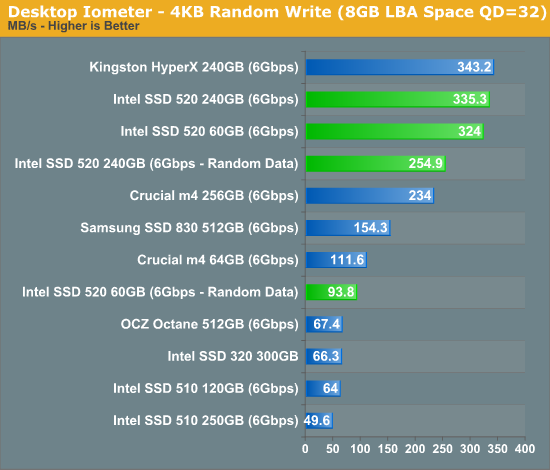
At higher queue depths the HyperX catches up to and surpassed the 520, perhaps indicating that Intel has done some work to optimize low queue depth performance on the 520 (likely what most end users will encounter).
Sequential Read/Write Speed
To measure sequential performance I ran a 1 minute long 128KB sequential test over the entire span of the drive at a queue depth of 1. The results reported are in average MB/s over the entire test length.
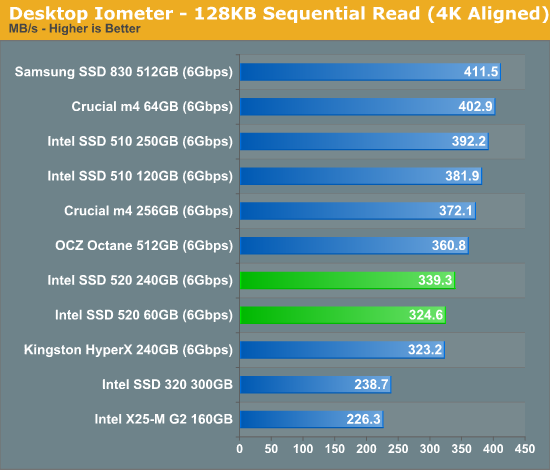
Sequential read performance is actually a bit lower than Intel's 510, but still higher than a standard SF-2281 drive.
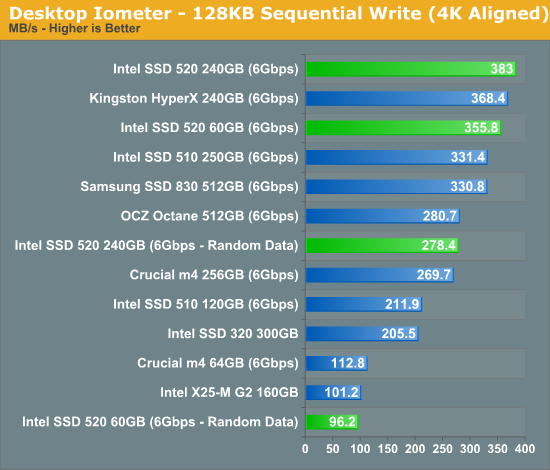
It's important to note just how close the 520's peak random write performance is to its sequential write performance. A big part of this is obviously that the SF-2281 is throwing away a lot of the data it has to write, but even if we compare incompressible 4KB random write to highly compressible 128KB sequential write we see a good ratio. The closer those two values are the more optimal the controller/firmware design is as, in theory, smaller random writes should be grouped to effectively become large sequential writes from the perspective of the NAND.










138 Comments
View All Comments
Iketh - Monday, February 6, 2012 - link
That price premium is doing me in, plus the irrecoverable drive thrashing. The 240gb Samsung will be my next purchase.Galcobar - Monday, February 6, 2012 - link
Find yourself having to ship a less reliable drive back to the manufacturer and the price premium disappears. At that point, not having to deal with the downtime and inconvenience of reinstallation is all gravy.Shadowmaster625 - Monday, February 6, 2012 - link
These drives are all built to pretty much the same physical quality standards. Firmware might be a different story, but for firmware it usually doesnt require a trip to the factory. Do you have any evidence to suggest that the physical build quality of an OCZ Vertex 2 is less than an Intel X-25?hackztor - Monday, February 6, 2012 - link
I had a vertex 1 that I had to ship back 4 times, finally I asked for a newer model. Got back the vertex 2. That right there is what Galcobar was talking about. Each time shipping is usually 10 bucks and about 2 weeks turn around time. Sometimes higher premium for better tested parts is worth the extra cost.pc_void - Monday, February 6, 2012 - link
The key word is sometimes.And sometimes you pay a higher price and have the same thing happen.
However, you can make an educated guess based upon lots of research. It still doesn't mean it won't happen.
Flunk - Monday, February 6, 2012 - link
I don't think firmware alone is responsible for the much lower failure rates of Intel SSDs over say... OCZ.I'm not saying other brands are bad, my Vertex 2 is still going strong with no issues, but these SSDs are built a little bit better than OCZ's drives and most of the other competition.
coder543 - Tuesday, February 7, 2012 - link
It's widely known that non-Intel SSDs have reliability issues. Recently they've gotten much better, but they still aren't yet comparable.taltamir - Monday, March 26, 2012 - link
The issue is that there are firmware bugs that intel fixed that sandforce and its other partners do not.You are right that there is no need to ship it back to the manufacturer... because they CANNOT fix it. A replacement drive will have the same bugs.
Your only recourse is to live with the bugs and BSODs or sell it second hand and buy an intel.
dmprok - Sunday, April 1, 2012 - link
I got Intel X-25 80Gb drive that failed on me TWICE in one year and I lost data. I picked Intel for TRIM function and because it was highly rated. First drive was purchased for $280 by my friend and it failed on him in 2 weeks, I thought he was doing something wrong, I bought dead drive from him and RMA'ed. It failed again for me in 6 months, one day computer just would not boot, I send it to RMA and got my 3rd drive, I hesitated to install for few months because I lost all faith in Intel SSD drives. I am not a heavy user, I don't run my PC 24/7, also the last drive drive I received does not look like quality made at all, the top of the drive is warped, I am disappointed, considering getting new Sandisk SSD for next upgrade.nsanity - Tuesday, February 7, 2012 - link
Having to ship a drive back means *absolutely nothing*. Hell, having to buy a complete new drive means nothing. The lost productivity when a business who has used a pair of SSD's as a shortcut to IOPS, as the machine BSOD's or drops an array till the system is physically powered off and on again simply dwarfs those costs.I'm a SMB Integrator and having to clean up after the mess of others who have used SF-2281 drives (Corsair Force 3 in particular) to achieve superior IOPS as opposed to using tried and true SAS arrays.
Random BSOD's and array's falling off a system is the plague i've seen with the SF-2281's. Firmware updates have really done nothing to help on the Corsair Drives.
On the Corsair Force 3 release, to enthusiast/gamer customers, I sold 3 drives, only to RA them 5 times within a month.
From that point I essentially told all my enthusiast customers that I would not sell them a Sandforce-based Drive, because I simply do not like unhappy customers, and nothing is more unhappy than someone bringing me a drive back within 48 hours.
I realise my sample size is small (Probably about 20-30 SSD's total), but I can tell you that out of the 15 Intel Drives I've seen/touched/supported (X-25M G2's, 320's and 510's), none of them have had any faults what so ever. Every, single, SF-2281 drive has had faults.
The advent of Intel making Sandforce based drives leaves me with very uneasy. Intel's reliability is second to none, but I need more than just an anecdotal review telling me that they've "fixed" the SF-2281. I've been burned on a small scale, and i've watched a fellow SMB integrator friend lose thousands of dollars in free labour trying to repair systems based on these drives.
I'm looking forward to Anand's part two, using these drives in an Enterprise scenario - and hopefully he's got a machine doing heavy load testing in the mean time to better report on the reliability- or otherwise of these drives.